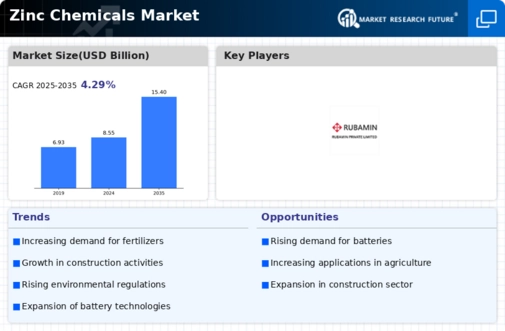Zinc Chemicals Size
Zinc Chemicals Market Growth Projections and Opportunities
Global Economic Trends: Economic conditions worldwide play a crucial role in shaping the zinc chemicals market. During periods of economic growth, industrial activities increase, leading to higher demand for zinc chemicals in various applications such as rubber compounding, agriculture, and pharmaceuticals.
Technological Advancements: Innovations in manufacturing processes and product development can affect the zinc chemicals market. Advancements that improve the efficiency of zinc chemical production or introduce novel applications can create new market opportunities and drive growth.
Regulatory Environment: Regulatory policies concerning environmental standards, product safety, and trade tariffs can have a significant impact on the zinc chemicals market. Compliance with regulations and adherence to industry standards are essential considerations for market players.
Price Volatility of Raw Materials: The prices of raw materials used in the production of zinc chemicals, such as zinc ore and sulfuric acid, can fluctuate due to factors like mining output, geopolitical tensions, and currency exchange rates. These fluctuations influence production costs and ultimately affect market prices.
End-Use Industries: The demand for zinc chemicals is closely tied to their application in various industries. For example, the automotive sector utilizes zinc chemicals in anti-corrosion coatings, while the agriculture industry relies on them for fertilizers and animal feed additives. Changes in these industries can impact market demand.
Emerging Markets: Growth opportunities in emerging economies present significant prospects for the zinc chemicals market. Rapid industrialization, urbanization, and infrastructure development in regions such as Asia-Pacific and Latin America drive the demand for zinc chemicals in construction, electronics, and other sectors.
Competitive Landscape: The competitive environment within the zinc chemicals market, characterized by the presence of key players and their strategies, influences market dynamics. Factors such as pricing strategies, product differentiation, and mergers and acquisitions can impact market competition and profitability.
Environmental Concerns: Increasing awareness of environmental issues and sustainability drives the adoption of eco-friendly alternatives in various industries. This trend can lead to changes in product formulations and production processes within the zinc chemicals market to reduce environmental impact and meet regulatory requirements.
Consumer Preferences: Changing consumer preferences and purchasing behavior can influence the demand for products containing zinc chemicals. For instance, the growing preference for organic and natural ingredients in personal care products may drive the demand for zinc oxide in sunscreen formulations.





Leave a Comment